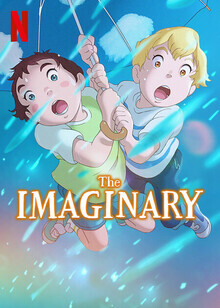The Imaginary

Born from the still unbridled creativity of children, where an empty room and a random assortment of objects can inspire the most whimsical of adventures, imaginary friends respond to each young mind’s needs for companionship. The intricacies of these invisible entities and their relationship to their human creators is the subject of Japanese director Yoshiyuki Momose’s animated feature “The Imaginary,” which he adapted from the 2014 British novel by A.F. Harrold and Emily Gravett’s illustrations for that original tome.
Momose’s dazzlingly vibrant and heart-rending fantasy arrives on American screens mere weeks after John Krasinski’s recent live action/animation hybrid “IF” and just over a month ahead of the 20th anniversary of the Cartoon Network show “Forster’s Home for Imaginary Friends,” both fictions that navigate incredibly similar worlds of make-believe pals.
Amid shape-shifting landscapes and a starry sky, Rudger (voiced in English by Louie Rudge-Buchanan), a blond boy, introduces the realm where he and Amanda (Evie Kiszel), the young girl who conjured him up, spend time together. Though Rudger has the appearance of being Amanda’s age, he’s only been around for a few months—since the passing of the girl’s father. His presence provides Amanda with comforting support as she grapples with grief. She and Rudger have promised to protect each other and to never cry.
Produced by Studio Ponoc, the company behind “Mary and the Witch’s Flower” and staffed with several Studio Ghibli-trained artists, the animation exhibits a ravishing fluidity, particularly in magical locations where items on screen transform rapidly to keep up with the kid’s visions. Momose himself worked in the animation department of bona fide masterpieces such as “Grave of the Fireflies,” “Princess Mononoke,” and “Spirited Away.” His experience under Hayao Miyazaki and Isao Takahata reflects here in both the poignant, yet not cloying treatment of the material and the warm aesthetic on display.
Certain elements and effects, such as a flock of origami birds, make the use of digital technologies to complement the mostly hand-drawn characters obvious. Yet, the exquisitely detailed backgrounds in Amanda’s home, which doubles as a bookstore, and later in the parallel universe where imaginary friends dwell, showcase the caliber of artistry here. A single frame of “The Imaginary” can outshine the mass-produced, visually uninspired animation in some of the American offers targeting the same demographic.
Amanda lives with her stressed out mother, Lizzie (Hayley Atwell), who has lost touch with that free-spirited part of herself that allowed her to have her own imagery buddy, Fridge, many years in the past. And because adulthood has made her weary and wary of fanciful ideas, Lizzie fails to hear Amanda’s concerns about a visit from a villain: Mr. Bunting, a sort of imagination vampire, and his own ancient imaginary companion: a terrifying, long-haired, dead-eye girl in old-fashioned attire who looks as if lifted from a supernatural horror film. Bunting has lived for hundreds of years thanks to the energy he steals when eating imageries; the more emotionally complex the creation he swallows is, the more intense his lifeforce becomes. Rudger’s unwavering devotion for Amanda stirs his appetite.
When an accident separates Amanda and Rudger, the latter crosses the threshold into a world where imaginary friends whose owners have forgotten them hide in order not to disappear completely. That’s when “The Imaginary” opens the door to the need for substantial exposition and begins to feel narratively convoluted. The rules by which the imaginary friends must abide come to us in the form of explanatory dialogue and even then more questions arise. These out of commission imaginaries can get one day gigs to serve as temporary playmates to children who, for an unexplained reason, don’t have one of their own. As more imaginaries are introduced, some who look human like Rudger and others who are hybrid animals or inanimate gadgets made sentient, the plot spirals into an all-out battle between reality and fantasy where some of the knotty mechanics mystify.
Even with its shortcomings on the writing front, “The Imaginary” still yields an affecting resolution that brings together Amanda and Lizzie. That it lands on Netflix on the same weekend that “Despicable Me 4” opens in theaters illustrates the vast intellectual and artistic abyss that separate their approaches to family-friendly animation. Had there been interest, an American studio could have potentially produced a Hollywood take on A.F. Harrold’s English-language book, but instead young audiences around the world get another sequel where the Minions speak in unintelligible gibberish or scream “Banana!”




